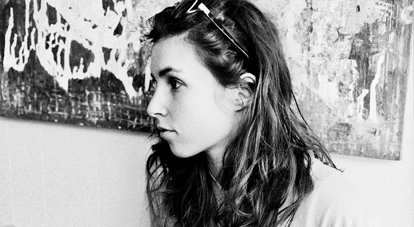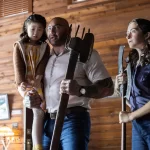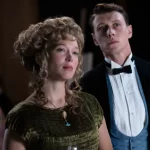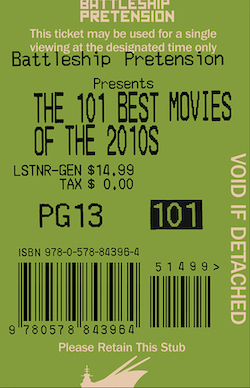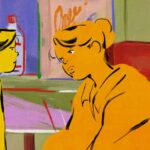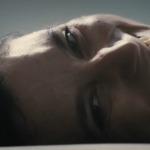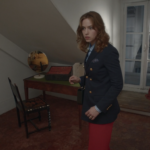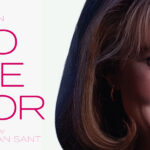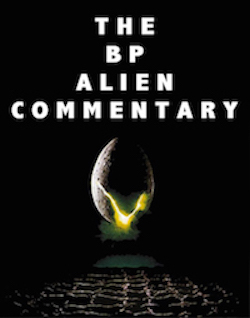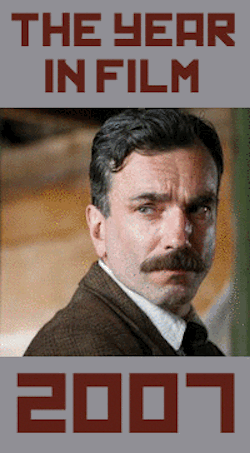A Discussion with Sophia Takal, by Scott Nye
There are two major films from AFI Fest that I’ve been, and will continue to be, very vocal in promoting. The first is Bela Tarr’s The Turin Horse, which is a masterpiece of the highest order, but the other was actually the first film I saw at the festival – Sophia Takal’s debut feature, Green. I was astonished not only by the sureness of her vision, but more urgently by the nakedness of her emotion. There are very few times when you get to praise a filmmaker for pouring all of themselves out onto the screen, and doing so as successfully as she has, so when a film such as this comes along, it’s difficult to not become evangelical.
I had the opportunity to talk to Ms. Takal and her co-star, producer, and fiancee, Lawrence Michael Levine, about all of this at the Roosevelt Hotel the day after the film screened. She was as forthcoming in the interview as she was in her film, and I asked her right away if there was any concern when she was writing or directing that maybe she was putting too much of herself out there. I was thinking of, but did not mention, Ingmar Bergman’s similar concern when making Persona and Hour of the Wolf, which is why both of those films contain direct reminders of their own medium, and the production process that goes into making them, in an effort to give the audience some distance. Takal, however, had no similar concerns.
“Maybe [I held back] for the audience’s sake,” she said. “But really, I believe that the more personal it gets the more universal it becomes. If you make something that you don’t really understand, it will be broader and less truthful. I’ve always thought that, and I’ve always responded to movies that seemed like the filmmakers were really putting everything into their films.”
“Any in particular?” I asked, hoping for, and delighted in, the film-nerd conversation that followed, in which we discussed A nous Amour, Love Streams, Persona, and especially Robert Altman’s 3 Women, with which Green has a lot in common.
“I remember I had the idea for [Green]. An idea for the overarching themes and plot anyway; I didn’t have a script or anything. And then I saw [3 Women] and I went ‘dammit!’
I wanted to interject that while her film has a lot in common with 3 Women, it feels more like an inspiration, much as Persona was a clear inspiration for Altman, but not the end of the road. But before I could say too much, she was off and running.
“There were a lot of parallels or comparisons that I’ve heard people make, but I haven’t seen most of them. Or I have now, after the film was done. But in general, [I was inspired by] movies where you’re reminded that movies don’t need to be what everyone calls a movie. Like 3 Women is amazing because it’s really subjective and psychological…and weird! And I feel like that’s getting less and less common to be able to make those kinds of films.”
In the film, Levine plays Sebastian, who along with his girlfriend, Genevieve (Kate Lyn Sheil) sets up life on a farm to attempt a life of sustainable living and write about their adventures as people from Brooklyn living a country life. They soon meet Robin (Takal), and while both are initially put off and annoyed by her, their relationship evolves as trust issues between Sebastian and Genevieve are brought to bear.
As Takal was coming from a background in acting (which she studied in college, and was her entry point into filmmaking), I wondered if she was tempted to cast herself as the lead.
“There was the temptation from the ego point of view that I want to be the lead,” she admitted, “but I think Kate and I are suited to the roles we play, so it just made sense from the beginning that she would be.”
It’s a decision that pays off, not just because Sheil is incredible in the role (and Takal in hers), but it also gives the audience some necessary distance. The film is so confessional and personal that, had she played the lead, it would inevitably feel a little self-indulgent, even though the material is still so strong.
I was so impressed with the quality of her direction, especially as a first-time filmmaker, and asked a few questions about her process.
“It was really chaotic sometimes,” she said, “and a lot of the process involved me asking Larry for his opinion or advice and then yelling at him for giving it to me, and telling him to stop trying to take control of the movie. So that was the first week.”
The film had a pretty unique production process – Takal wrote the first thirty or so pages, as well as the last ten, but planned to improvise the rest. When they completed a week of shooting, however, she wasn’t satisfied with the result, so she incorporated the improvised scenes into a fully fleshed-out screenplay. The final film does feel very improvisatory, so I was surprised to learn how thoroughly it was scripted, but that’s a huge testament to both her writing and the performances.
“The first week I was really nervous. We had a different person shooting than the final DP, and [the first guy] had never shot a feature before, I’d never directed a feature. I was really inarticulate; I didn’t know what I wanted. He was really impatient. I twas really stressful. That’s when I turned to Larry a lot. But then we took some time off and then my friend Nandan [Rao], who’s amazing, shot it. He shot a lot of stuff we hadn’t shot yet, but then we were so efficient with him that we ended up going back and reshooting a large portion of that first week.”
I was stunned by the film’s camerawork, especially a couple of dialogue scenes in which nothing of much importance is discussed, but there is so much emotional tension conveyed in the performances. In these moments, the camera will also drift back and forth between the participants in such a way that seems like it had to be intensely blocked, but feels totally found. It creates a dreamlike atmosphere (not unlike, again, 3 Women), and it shows tremendous confidence as a director to settle on one set-up for a single scene. Dialogue scenes are the most throwaway element of much of modern filmmaking, so it was so refreshing to see a film that thought about how the camera could add to, and inform, what’s being discussed, and how they discuss it.
“The hummus scene is great, right?” She said, addressing one of the specific scenes I mentioned to her (also, her excitement would seem self-aggrandizing if a) she hadn’t earned it, and b) she hadn’t said what you’re about to read). “I watched that…that was like the second time we did that and like, Larry was still reading off of a script, but I thought the performances were so good in that, and Nandon was just in the right place at the right time. He’s just an amazing cinematographer, that’s all there is to it. He just knows exactly where to be. And it just makes it so much easier; I really can’t take credit for that. He just knew.”
At this point, Levine came over to chime in. Takal takes a lot of her inspiration from him, and while it seems to stem from a lot of the negative emotions she put onscreen, it’s hard to argue with the results.
“It was actually, if we think back, when we did Gabi on the Roof in July [which he directed and she produced], we wanted it to be long, unbroken takes, but there were too many characters and too much going on, so we ended up using jump cuts.”
I talked a lot with her and Lawrence about his role in the film, which I found fascinating, and since the film comes from such a strong, female perspective (which is different that a strong female perspective), he tends to not come up a lot in interviews. I’m going to leave that part out, as it gets into a lot of spoiler territory – even though the film does not have distribution, I do hope you’ll have the opportunity to see it. But I was really taken by how much thought they had clearly put into the role (and the other two as well), how thoroughly they were able to explain it, and most interestingly, how their interpretations of his exact role differed in some of the details, which explains how the performance feels so alive.
Lastly, I asked her about how she settled on the region, which is a little ambiguous in the film. I landed on Pennsylvania as there’s a license plate in the film from that state, but she said she was aiming for a more southern locale.
“We wanted the characters to be somewhere far away, culturally, and physically. Where we shot is really only two hours outside of New York, so I didn’t want it to be set there, because she could just go back and visit her friends every weekend. We have a few friends who live in Virginia, and I felt that the landscape of where we shot reminded me of towns in that area. I wanted there to be a lot of superficial differences between Genevieve and Robin, like her accent, and her educational background, because I really thought a more interesting friendship could develop if they didn’t have the sort of standard things to talk about, like their favorite movie, or their favorite band.”
After I stopped recording, we talked a little bit about the distribution potential, coming somewhat from a selfish perspective as I really, really want to see the film again. While they didn’t get into specifics, I think all of the stuff they talked about should probably stay confidential for the time being. I want to restate that this is an exceptionally approachable film, even though it addresses some emotional impulses we’re not always so proud of. I told them, and I meant it, that I know a lot of people would love the film as much as I did, and at the very least be interested in seeing it, if they had a chance to hear about it.
I really enjoyed the chat, and the insight into the process of making the strongest debut I’ve seen all year. If you get any kind of chance to see it, I cannot urge you strongly enough.

